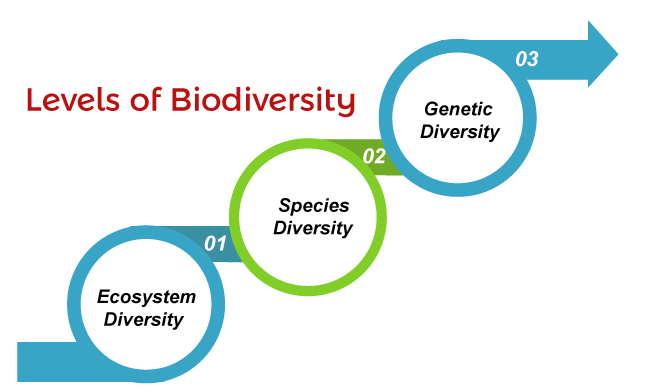Levels of BiodiversityThe sum of all the varied plant species, mammals, fungi, and microbiological organisms that dwell on Earth, as well as the various habitats in which they live, is known as biodiversity. The genetic information contained in these creatures is also included in biodiversity. Biodiversity is derived from two words: bio, which means life, and diversity, which means variety. Biodiversity refers to the diversity of all living organisms, encompassing the numerous plants, creatures, and microbes, as well as the genetic data and ecosystems that they create. 
1. Genetic diversityWithin a species, genetic diversity refers to the number of genes present. Every species is made up of people with their own unique genetic make-up. This indicates that a species may have many populations, each with its own genetic makeup. Diverse populations of an ecosystem should be protected in order to preserve genetic diversity. Through genetic linkages, all animals on Earth are related in some way. And the closer two species are connected, the more genetic code the two populations will exchange. These organisms will also have a more comparable appearance. Hair, three bones in the middle ear, and the ability to milk their young are all characteristics shared by mammals. Similarly, all mammals are descended from vertebrates. Vertebrates are backboned creatures. Fungus, plants, and some microbes all have the identical cellular structure as animals. Finally, the ribonucleic acid (RNA) molecule is found in all living things. Furthermore, the majority of them include deoxyribonucleic acid (DNA). Genes are the fundamental building blocks of all existence on the Planet. They are in charge of both the commonalities and contrasts that exist between organisms. 2. Species diversityThe diversity of species observed within a habitat or region is referred to as species diversity. Many species can be found in some ecosystems, such as rainforests and coral reefs. Others have fewer, such as salt flats or a filthy creek. Every ecosystem has its own assortment of species that interact with one another. Certain habitats may well have a significantly higher number of species than others. One species has grown so huge in some habitats that it now dominates the natural community. When comparing ecosystem biodiversity, an ecosystem with a big number of species but no species that outnumbers the others is said to have the most species diversity. Even if some species go extinct, a vast variety of animals can assist an environment to rebound from environmental hazards. 3. Ecosystem diversityThe diversity of habitats in a specific location is referred to as ecological diversity. An ecosystem is a population of organisms that engage with their physical surroundings. A vast environment, such as a forest, or a tiny ecosystem, such as a pond, are both examples of ecosystems. An area may well have multiple ecosystems or only one. Oceans or deserts with large swaths of land would be examples of low ecological diversity locations. In this respect, a mountainous location with lakes, woods, and grasslands might have more biodiversity. When one environment is endangered by drought or disease, a region having many ecosystems could be able to supply more resources to assist local species to thrive. Biodiversity is crucial to the functioning of habitats and the advantages they deliver. The following are some of the advantages of biodiversity:
4. Functional DiversityFunctional diversity refers to how different species act, get food and exploit an ecosystem's natural resources. Because there are so many species with so many distinct behaviors, a species-rich environment is said to contain a lot of functional variety. Knowing the behaviors and responsibilities of species can point to gaps in the food chain or ecosystem niches that are lacking species, which can be helpful to ecologists working to maintain or restore a damaged ecosystem.
Next TopicBlack Fungus (Mucormycosis)
|
 For Videos Join Our Youtube Channel: Join Now
For Videos Join Our Youtube Channel: Join Now
Feedback
- Send your Feedback to [email protected]
Help Others, Please Share









